Easy Moroccan Couscous Recipe: Simple & Delicious
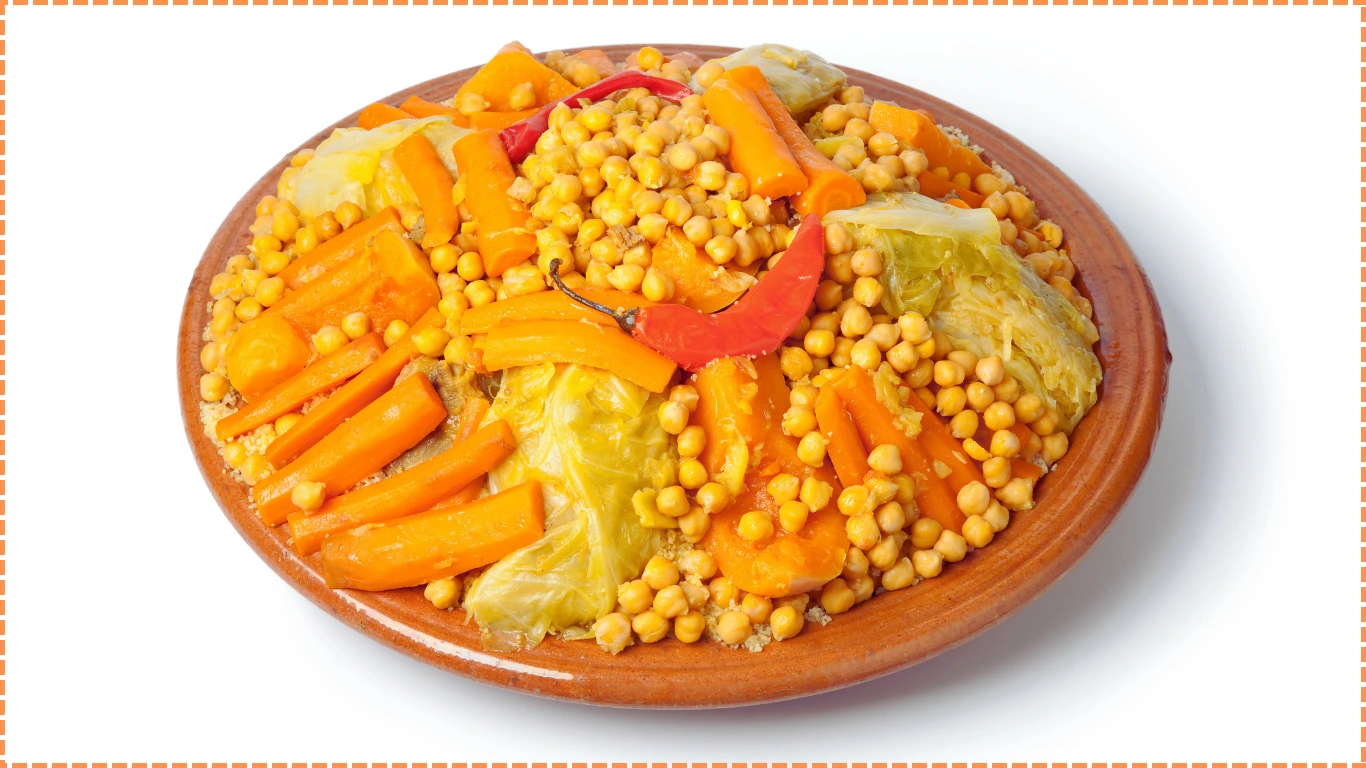
Table of Contents
Moroccan couscous is renowned for its rich flavors, aromatic spices, and intricate cooking techniques. At the heart of many Moroccan meals lies couscous, a staple dish that has been enjoyed for centuries. Traditional Moroccan couscous is not just a dish; it is an experience, often shared with family and friends around a communal table. This guide explores the history, ingredients, preparation methods, and variations of authentic Moroccan couscous, providing a detailed recipe for you to try at home.
The History of Couscous
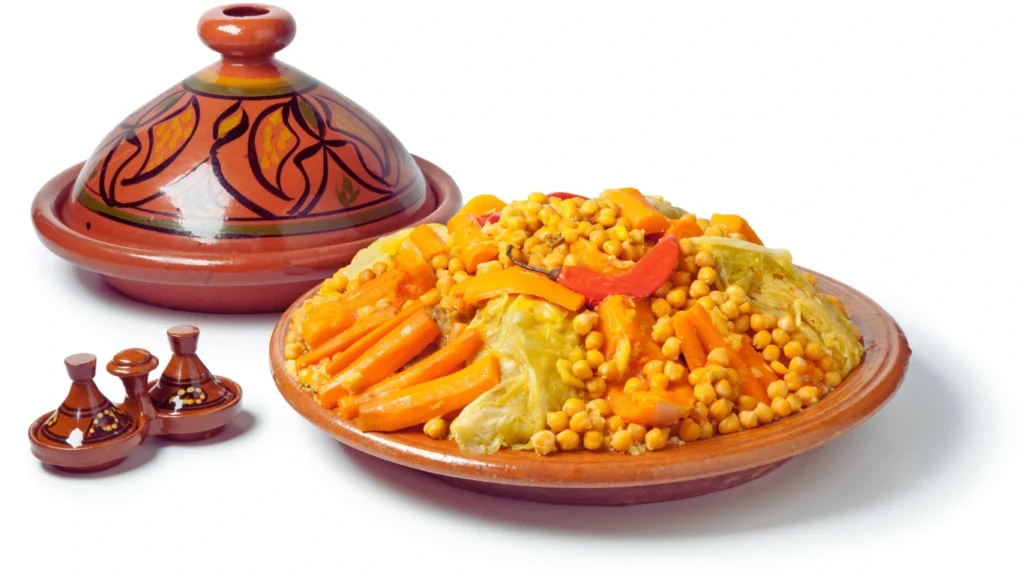
Couscous has deep roots in North African culinary traditions. Its origin dates back to the Berbers, an indigenous people of North Africa, who are credited with its invention. Over centuries, couscous spread across the Maghreb region, encompassing Morocco, Algeria, Tunisia, and Libya. Each region developed its own unique take on the dish, but Morocco’s version stands out for its exquisite use of spices and variety of ingredients.
Couscous symbolizes abundance and hospitality in Moroccan culture. It is often served during special occasions, family gatherings, and religious celebrations such as Eid or the end of Ramadan. Traditional Moroccan couscous is typically prepared on Fridays, the holy day in Islam, following the communal prayers.
VIEW :moroccan-roasted-chicken
Ingredients for Traditional Moroccan Couscous
The beauty of Moroccan couscous lies in its versatility and the harmonious combination of ingredients. Below is a list of the key components used in a classic couscous recipe:
Couscous Base:
- 500g medium-grain couscous
- 2 tablespoons olive oil
- 1 teaspoon salt
- 500ml water
Vegetables:
- 2 large carrots, peeled and cut into chunks
- 2 zucchinis, cut into quarters
- 1 small cabbage, quartered
- 2 medium turnips, peeled and halved
- 1 large onion, finely chopped
- 2 tomatoes, diced
- 1 sweet potato, peeled and chopped
Legumes and Proteins:
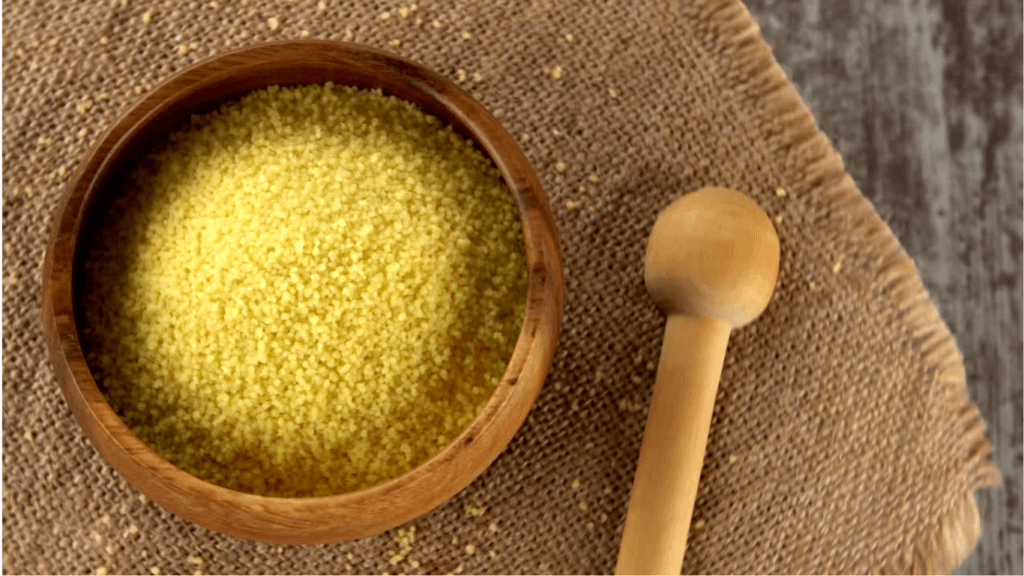
- 1 cup chickpeas (pre-soaked or canned)
- 1kg lamb or chicken (optional)
Spices and Seasonings:
- 1 teaspoon ground ginger
- 1 teaspoon ground cinnamon
- 1 teaspoon turmeric
- 1 teaspoon paprika
- 1/2 teaspoon black pepper
- 1/4 teaspoon saffron threads (optional)
- Salt to taste
Garnishes:
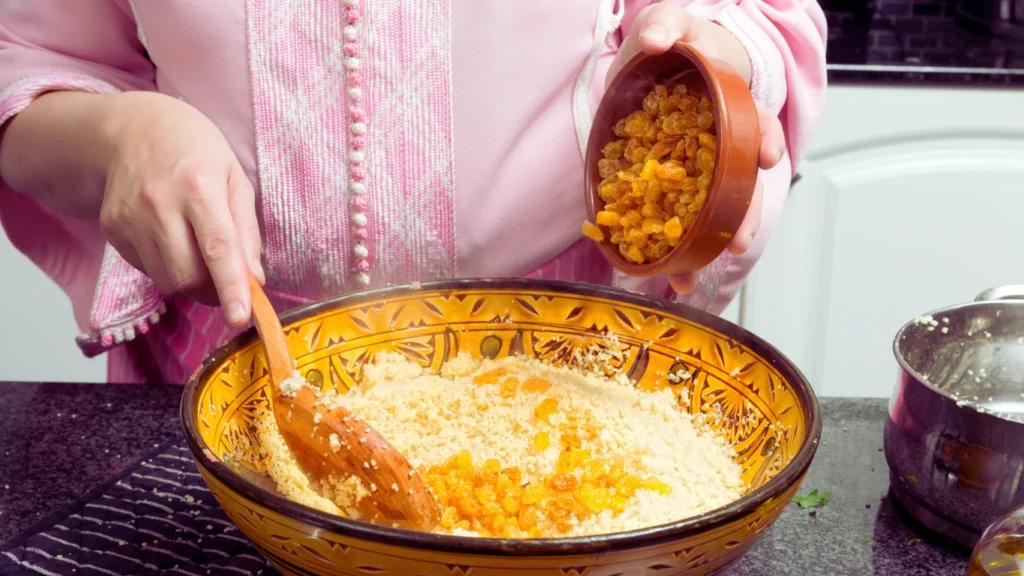
- 1 cup raisins (optional, soaked in water)
- 1/2 cup toasted almonds or pine nuts
Broth:
- 2 liters water or chicken/vegetable stock
- 2 tablespoons tomato paste
Traditional Cooking Equipment
To prepare Moroccan couscous authentically, a special cooking pot called a couscoussier is used. This pot consists of two parts: the bottom section for cooking the stew or broth and the top section for steaming the couscous. Steaming the couscous multiple times ensures a light, fluffy texture.
Step-by-Step Preparation
Step 1: Prepare the Vegetables and Meat
- Heat olive oil in the bottom part of the couscoussier or a large pot over medium heat.
- Add the chopped onion and sauté until translucent.
- If using meat, add it to the pot and brown on all sides.
- Stir in the spices (ginger, turmeric, paprika, cinnamon, saffron, and black pepper) and mix well to coat the meat.
- Add the diced tomatoes and tomato paste, cooking until the tomatoes soften.
- Pour in the water or stock, then add the carrots, turnips, cabbage, and sweet potato.
- Cover and let simmer for 30 minutes before adding the zucchini and chickpeas. Continue simmering until all vegetables are tender.
Step 2: Prepare the Couscous
- Place the couscous in a large bowl and drizzle with olive oil. Rub the grains between your palms to coat them evenly.
- Add a teaspoon of salt and 250ml of water, mixing gently.Allow the couscous to soak up the water for 10 minutes.
- Transfer the couscous to the top section of the couscoussier. Steam for 15-20 minutes.
- Remove the couscous and spread it out on a large platter or tray. Sprinkle with additional water and fluff with a fork or your hands to break up clumps.
- Repeat the steaming process twice more, ensuring the couscous becomes light and airy.
Step 3: Assemble the Dish
- Once the couscous is fully cooked, arrange it on a large serving dish, forming a mound.
- Make a well in the center and ladle the cooked meat and vegetables into it.
- Drizzle some broth over the couscous to keep it moist.
- Garnish with raisins and toasted nuts for added flavor and texture.
Variations and Tips
- Vegetarian Version: Replace the meat with more vegetables, such as pumpkin or eggplant, and use vegetable stock for the broth.
- Sweet and Savory Couscous: Add caramelized onions, a touch of honey, and extra cinnamon for a sweeter profile.
- Spicy Couscous: Incorporate harissa or chili flakes into the broth for a spicier kick.
- Serving: Couscous is traditionally eaten communally, with everyone using spoons or their hands to partake from the same dish. However, it can also be served individually.
- Storage: Leftover couscous can be refrigerated for up to three days and reheated by steaming or microwaving with a bit of added liquid.
Traditional Moroccan couscous is a testament to the country’s rich culinary heritage. Its preparation requires patience and attention to detail, but the result is a deeply satisfying dish that brings people together. Whether you are hosting a festive gathering or seeking to explore the flavors of Morocco in your kitchen, this recipe provides a perfect starting point for an authentic experience. Enjoy your couscous with a side of mint tea for a truly Moroccan touch!
Sweet Couscous with Milk (Seffa Medfouna)
Seffa Medfouna is a sweet variation of couscous in Moroccan cuisine, typically enjoyed as a dessert or for special occasions. It features steamed couscous paired with warm milk, sugar, and an assortment of sweet toppings. Here’s how to make it:
Ingredients:
- 500g fine couscous
- 2 tablespoons butter
- 1 teaspoon salt
- 1 cup powdered sugar
- 1 liter warm milk
- 1/2 cup raisins (optional, soaked in water)
- 1/2 cup ground almonds
- 1 teaspoon ground cinnamon
Preparation:
- Steam the fine couscous using the same method mentioned earlier, ensuring a light and fluffy texture..
- After cooking, transfer the couscous to a large serving platter.. Mix in the butter and a teaspoon of salt.
- Shape the couscous into a mound on the platter. Sprinkle generously with powdered sugar, ground cinnamon, raisins, and ground almonds.
- Serve the couscous with a side of warm milk. Diners can pour milk over their portions to taste.
Conclusion
Traditional Moroccan couscous embodies the rich culinary heritage of Morocco. While its preparation demands patience and precision, the outcome is a deeply fulfilling dish that brings people together. Whether you’re hosting a celebration or exploring Moroccan flavors in your own kitchen, this recipe offers an ideal introduction to the authentic taste of the country. Pair your couscous with a refreshing glass of mint tea for an extra touch of Moroccan tradition!
1. What is Moroccan couscous?
Moroccan couscous is a staple dish made from steamed semolina grains, often served with a flavorful broth, vegetables, and sometimes meat. It is a key part of Moroccan cuisine and is traditionally prepared with great care.
2. What type of couscous should I use?
For authentic Moroccan couscous, use fine semolina couscous rather than the instant variety. Traditional couscous requires steaming multiple times for the best texture.
3. Do I need a special pot to cook couscous?
Ideally, a couscoussier (a two-tiered pot) is used, where the bottom holds the stew, and the top steams the couscous. However, a fine-mesh steamer or a colander over a pot can work as an alternative.
4. Can I make Moroccan couscous without meat?
Yes! Moroccan couscous can be made vegetarian by using vegetable broth and loading it with seasonal vegetables like carrots, zucchini, and chickpeas.
5. How long does it take to prepare traditional couscous?
Traditional Moroccan couscous takes about 2 to 3 hours, including steaming the couscous multiple times for the perfect light and fluffy texture.
6. What spices are commonly used in Moroccan couscous?
Common spices include cumin, cinnamon, turmeric, saffron, ginger, paprika, and coriander, which add warmth and depth to the dish.
7. How do I prevent couscous from clumping?
To keep couscous light and fluffy, fluff it with your hands or a fork between each steaming session and drizzle it with a little olive oil.
8. What vegetables are typically included?
Traditional Moroccan couscous features vegetables like carrots, zucchini, turnips, pumpkin, and chickpeas, cooked in a spiced broth.
9. Can I prepare couscous in advance?
Yes! You can steam the couscous ahead of time and reheat it by lightly steaming again or warming it in a pan with a splash of broth.
10. What is the best way to serve Moroccan couscous?
Couscous is traditionally served on a large communal platter with the broth and vegetables arranged on top. Serve it with harissa (a spicy chili paste) on the side and a glass of Moroccan mint tea for an authentic experience.
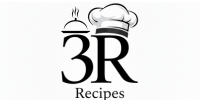
3 thoughts on “Easy Moroccan Couscous Recipe: Simple & Delicious”